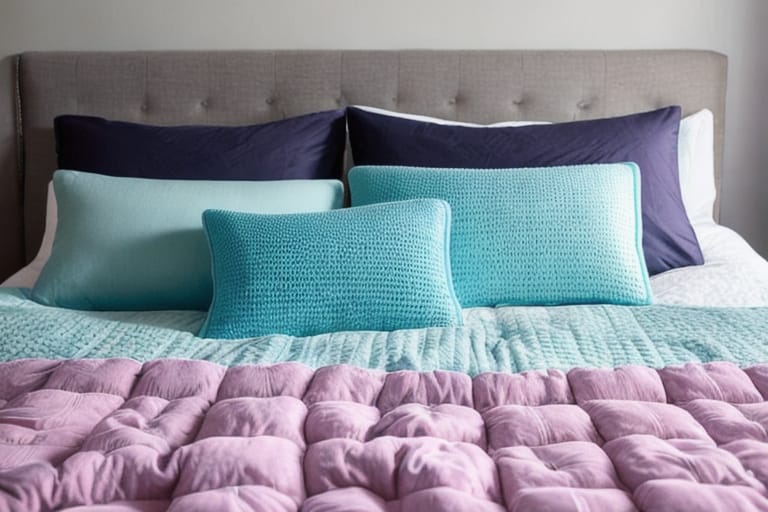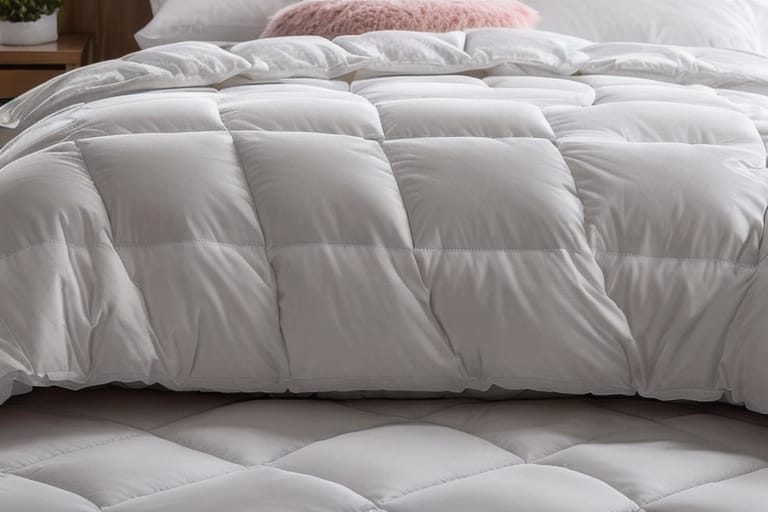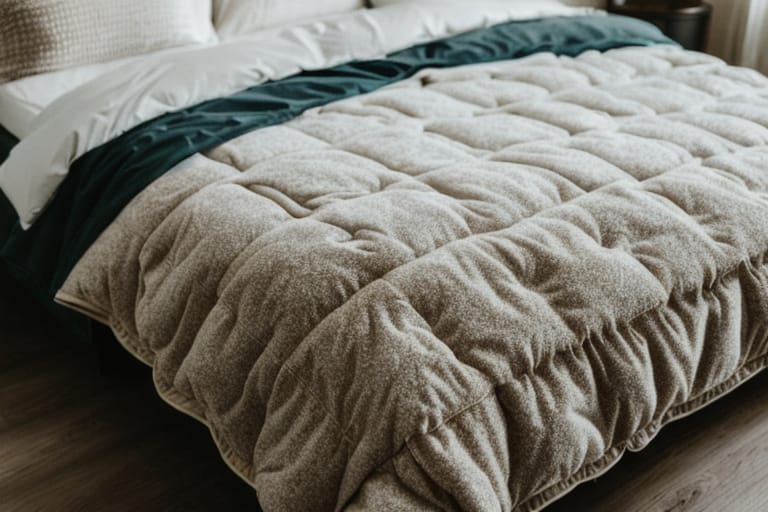Are you searching for a comforter that will keep you blissfully warm on cold winter nights without making you sweat when temperatures rise? Would you like something plush yet breathable that mimics the cloud-like softness of luxury bedding at a more affordable price point? Then a down comforter alternative could be the perfect solution for your sleep needs and budget.
What is a Down Alternative Comforter?
A down alternative comforter looks and feels incredibly similar to a genuine down-filled comforter, providing lofty warmth and comfort at a fraction of the cost. Rather than expensive duck or goose down, down alternative comforters are filled with various types of synthetic fills designed to emulate the heat-retaining properties of real feathers.
These polyester, microfiber and other synthetic materials cluster together to trap body heat just like down clusters from waterfowl. This creates plush loft and excellent insulation for staying cozy on cold winter nights. Unlike lower-quality comforters stuffed with just fill, down alternative mimics the structure of real bird feathers to achieve better warmth without the high costs.
Depending on factors like fill power and materials, the best down alternative comforters have impressive temperature regulation to prevent overheating. They also have breathability for comfort in all seasons.
Below we’ll explore what exactly makes a down alternative comforter, the key benefits over down, how to choose the best one for your needs, and the top options for a cozy warm night’s sleep:
Benefits of Down Alternative Comforters
Some of the main advantages of choosing a synthetic down alternative filling rather than natural goose or duck down include:
- Affordability – Down alternative comforters cost a fraction compared to similar down-filled options. You can find quality bedding without breaking the bank.
- Hypoallergenic – Synthetic fibers are less likely to trigger allergies than bird feathers and down.
- Easy Maintenance – Machine washing and drying typically causes less damage to synthetic fills.
- Animal-Conscious – No birds are harmed in making these cruelty-free comforters.
- Consistency – Alternative down maintains loft and insulation power better over time.
Below we’ll go into more detail on each benefit:
Affordable Cozy Comfort
The main appeal of a down alternative comforter is that you can get a luxury level of softness, breathability and insulation without luxury prices. Because the synthetic fill materials cost much less than expensive goose down, manufacturers can produce high-quality comforters at a budget-friendly price point for most sleepers.
Rather than $400-500+ for premium goose down bedding, you can find a top-tier down alternative comforter from around $100-$250 and still enjoy exceptionally soft, lofty and cozy warm comfort. This makes it easier to invest in top-of-the-line materials and construction features despite the lower cost.
Hypoallergenic Properties
For those with asthma, allergies, or sensitivities, the synthetic polyester fibers used in down alternative comforters tend to be far less irritating than natural feathers or down clusters:
“I purchased the down alternative comforter for my son who has terrible allergies. He has been sleeping through the night ever since he started using it.”
Look for hypoallergenic certification from textile testing organizations like OEKO-TEX if allergies are a concern. Quality manufacturers specialize in bedding for sensitive sleepers.
Easy Care and Durability
Genuine down comforters require special handling and dry cleaning to prevent damage, clumping, and reduced efficiency. Down alternative synthetic fills can withstand frequent machine washing and drying at home with less risk of degradation. This makes them a more durable, long lasting comforter option.
Most down alternative comforters only require occasional washing to restore loft and remain fresh. From quick cleanings when needed to weekly wash cycles, they hold up well over years of use.
Animal-Conscious and Sustainable
For animal-conscious shoppers, down alternative is the clear choice over natural feather and down bedding. Manufacturers use innovative synthetic fills to achieve the same softness, breathability and insulation without live-plucking geese and ducks. This makes choosing an alternative comforter better for sustainability and ethics.
Many down alternative fills also use recycled synthetics as input materials, giving them eco-friendly appeal. Look for companies that use Certified Safe recycled polyester and other sustainable materials.
Consistent Cozy Comfort
One common complaint of premium down comforters is that they tend to lose loft and warmth retention capacity over a few years of use. The delicate clusters of down tend to shift around with repeated wash/dry cycles, clump together, and degrade.
Down alternative synthetic fills are engineered for more consistent performance since the microfibers are arranged to interlock and trap air. So you can enjoy steady cozy comfort from a down alternative comforter over many years before needing to replace it.
Now that you know the main advantages of down alternatives, let’s compare how they differ from natural down comforters.

Down Comforters vs. Down Alternative – What’s the Difference?
While they feel very similar when new, there are some key differences between down and down alternative comforters related to materials, performance, and care.
Fill Materials
The main distinction comes down the fill used inside:
Down comforters use the soft under-plumage from ducks and geese harvested for food production. These delicate clusters provide unmatched warmth for their weight. But they come at a high price since availability is limited.
Down alternative comforters substitute various synthetic polyester fills to mimic the heat retention, softness and compression of down at a lower cost. Materials like PrimaLoft are specially engineered to cluster together like down using advanced fiber technologies.
Performance & Durability
When it comes to keeping you comfortably warm, down and down alternatives perform very closely when new:
- Warmth – Both provide excellent insulation and heat retention thanks to lofty fills that trap air. Higher fill power downs tend to provide more lightweight warmth, but lower fill power is comparable to synthetic alternatives.
- Softness – Alternatives mimic the cushy, pillowy feel of goose down very closely. But the highest end down still wins for plushness.
- Breathability – Better down alternatives maintain airflow well, but ultra-fine goose down breathes a bit better to prevent overheating.
- Durability – Over time, down tends to shift around and degrade more rapidly. Down alternatives maintain consistent warmth and loft over more years of use.
So while ultra-high quality down provides marginally better comfort initially, down alternatives compete remarkably well while holding up better long-term.
Care Requirements
Cleaning and care is where down alternatives really stand out from feather and down bedding:
- Washing – Down comforters require special handling and dry cleaning to prevent damage. Down alternatives can be machine washed and dried at home much more easily.
- Drying – High heat drying can ruin down’s loft completely. Down alternatives bounce back after machine drying.
- Longevity – With proper care down can last for decades. But down alternative synthetics are less prone to clumping and getting compacted over frequent washings.
For those wanting the ease of at-home cleanings, down alternative is certainly the more low maintenance option.
Cost and Value Comparison
Finally, thanks to lower material costs, down alternative comforters provide noticeably better value:
Down comforters provide unmatched lightweight warmth when using premium goose down. But the high price tags stretching into the multiple hundreds or thousands make cost-per-use very high.
Down alternatives get you around 90% of the comfort at a fraction of the price – just $100 to $250 for a queen-size. The value is impressive, letting you enjoy excellent bedding without breaking budget.
Now that you know the key differences in materials, performance, care, and value, let’s go over what to look for in the best down alternative comforters.
What to Look for in the Best Down Alternative Comforters
With a wide range of options available at different prices, you’ll want to compare factors like fabric, fill power, construction and special features when shopping.
Here are the key criteria to focus on:
- Fill Material – Quality down alternatives use innovative synthetic fills that closely mimic feathers. Look for siliconized polyester fibers, PrimaLoft and specialty microfibers.
- Fill Power / GSM – This indicates fluffiness and insulation level. For light warmth choose >300 GSM. For extreme warmth (like a duvet insert) choose >600 GSM.
- Fabric – Breathable, lightweight cotton, microfiber or eucalyptus viscose are ideal shell materials that complement synthetic fills.
- Construction – Baffle box stitching keeps fills evenly distributed instead of shifting around.
- Special Features – Some comforters add extra aesthetics, convenience functions and sensitivity protection.
- Warranty – Multi-year warranties back up claims of durability and performance.
We’ll explore what each specification means and how to choose the right option for your needs below.
Types of Down Alternative Fill Material
Just like types of goose down are graded by quality, warmth and softness, synthetic fills are engineered with different technologies, shape, sizes and materials:
PrimaLoft
Currently one of the highest rated synthetic fills, PrimaLoft uses advanced fiber technologies to closely match the insulation, compressibility and breathability of quality goose down. The fine microfibers interlock well to retain body heat exceptionally.
Siliconized Polyester
Silicon is used to coat synthetic fibers to maximize their softness and plush feel. This treatment allows polyester fills get as close as possible to emulating the cushy comfort of expensive down bedding.
Microfiber Fills
Clusters of synthetic microfibers interlock and contour around the sleeper’s body much like down. Microfiber thread counts are optimized for both cozy warmth and adequate airflow.
High quality down alternatives utilize these latest synthetic fills for premium comfort and durability.
Fill Power and GSM
Two key specifications related to fill are fill power and GSM (grams per square meter):
Fill power indicates the fluffiness, height and insulation level of the fill. Higher numbers mean more loft and air pockets for trapping body heat efficiently. 600-800 fill is common for quality down alternative comforters.
GSM refers to how many grams of fill are stuffed inside the shell fabric, per square meter area. Higher GSM numbers indicate more generous fill overall. Lightweight summer comforters might use 200 GSM. Ultra warm winter bedding can use >600 GSM.
Choose fill power and GSM based on your seasonal comfort needs:
- Summer – Lower fill power around 300-400 keeps open airflow to prevent overheating. Light overall fill <300 GSM is suitable.
- Winter – For sleeping warm in cold weather, choose >600 fill power and >400GSM fill density.
- All seasons – Middle fill ratings around 500-600 with 350-400GSM help moderate temperature year-round.
Ideally your comforter makes it easy to adjust temps as needed – cooling when it’s hot, warming when it’s cold.
Outer Fabric Shell
The outer shell encasing the down alternative fill plays a key role regulating temperature:
Cotton Shell – Breathable and moisture-wicking cotton allows airflow to prevent overheating. Choose high thread counts > 400 for softness.
Microfiber Shell – Lightweight, ultra-soft microfiber exterior feels luxurious and helps synthetic fills trap body heat.
Eucalyptus Viscose – Made from fast-growing eucalyptus trees, this sustainable fabric controls temperature naturally and feels silky soft.
Fabric shells shouldn’t add unnecessary weight or feel overly stiff. Opt for lightweight, breathable materials complementing the down alternative fill inside.
Construction and Stitching
How down alternative materials are arranged inside the exterior shell impacts their durability and performance.
Baffle Box Construction
Baffle boxes sew fabric walls between fill layers to prevent shifting around inside the comforter. This helps maintain consistent thickness and insulation:
Baffle boxes cost more to produce but prevent cold spots from developing over years of use.
Sewn-Through Construction
The exterior fabric is sewn right through all the fill layers to hold everything together simply:
This is quick to manufacture but can allow fill to shift around reducing warmth.
Stick with baffle box designs for best durability and heat distribution.

Top 5 Down Alternative Comforters of 2023
Now that you know what specifications to look for let’s compare some of the top-rated down alternative comforters combining quality materials, thoughtful designs and affordable price points:
1. Utopia Bedding Down Alternative Comforter
If you want a superior comforter without paying excessively, this affordable option from Utopia Bedding offers incredible quality and comfort rivaling ultra-plush down:
- 300 GSM siliconized fiberfill feels remarkably fluffy and breathable
- Premium microfiber outer shell provides sensuous softness
- Double needle baffle box stitching retains maximum loft
- Noiseless construction for undisturbed sleep
- Durable, tear-resistant materials built to last
- Easy care – machine wash and dry
- Oeko-Tex Standard 100 certified safety
With exceptional year-round comfort and quality nearly matching luxury down, you’ll be hard-pressed to find a better comforter at this very wallet-friendly price point. It makes a luxuriously cozy, fluffy addition achieving hotel suite-worthy comfort.
Frequently Asked Questions
What’s the difference between down and down alternative comforters?
The main difference is the fill material. Down comforters use a fill made from duck or goose feathers and down clusters. This provides unmatched warmth for the weight. Down alternative comforters substitute various synthetic fills made from microfibers that mimic the heat retention properties of down at a more affordable price point.
Is down alternative as warm as real down?
Quality down alternative provides around 90% of the insulating performance of premium goose down fills while costing much less. Thanks to innovations in synthetic fills over the past decade, the warmth, fluffiness and comfort of down alternative bedding now approaches that of fine duck and goose down.
How do I choose the right down alternative warmth?
Check the fill power and grams per square meter (GSM) specifications. For year-round, all-season use, look for around 500-600 fill power and 350-400 GSM density. For lightweight summer comfort, 300-400 fill power and <300GSM works well. For ultra cozy warmth in winter, choose >600 fill power and >400 GSM density.
Is down alternative really hypoallergenic?
Quality down alternative comforters utilizing synthetic polyester fills are intrinsically more hypoallergenic than natural feathers and down. But check for third party certification like OEKO-TEX Standard 100 to ensure strict testing guidelines for sensitivity. Leading bedding manufacturers design down alternative comforters specifically for allergy sufferers.
How long does a down alternative comforter last?
Thanks to durable synthetic fills that withstand repeated washings without excessive shifting or clumping like feathers, the best down alternative comforters maintain consistent warmth, loft and insulation for around 5-8 years depending on usage and care. This makes their long-term value quite high considering the reasonable upfront investment.








